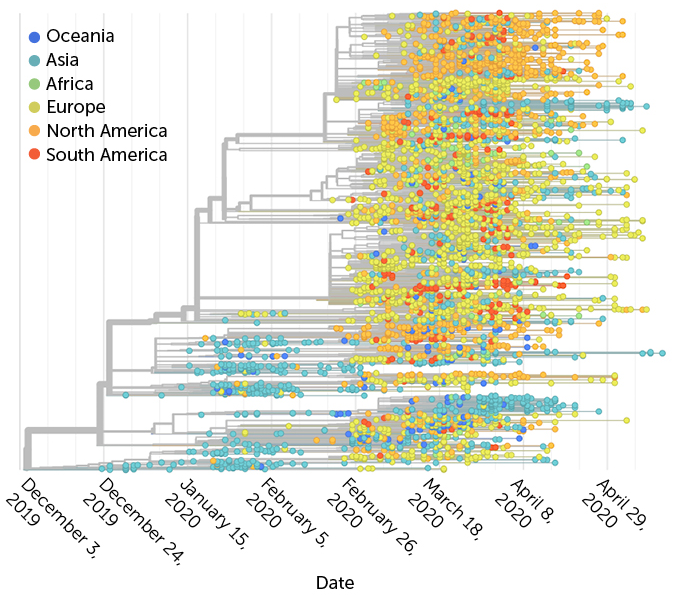TO WATCH “CLEARING UP THE COVID CONFUSION” WITH DR. CORRIGAN–> CLICK HERE)
This is great news, and probably something that most people failed to recognize the significance of. This is a bit long, but keep reading. You’re going to love the punchline.
Viruses normally mutate over time due to random processes that result in their viral genetics being unfaithfully replicated. All viruses change over time, with coronaviruses demonstrating an intermediate mutation rate compared to other viruses. They’re not the fastest, and they’re not the slowest. This process is normally thought to be completely random and not directed in any way, with certain mutations being selected preferentially over others as the virus competes against other variants in the pool.
This process, when compounded over time, normally results in the mortality and health impact of the virus being “attenuated”, meaning that the virus moves towards becoming more benign. This is because the variants which don’t cause humans to self-isolate due to sickness are the variants that survive by preferentially spreading through the population. The variants which are more harmful tend to fizzle out, and the benign variants spread form person to person because these “healthy” people are out and about. Viral attenuation is the reason why a virus may exhibit a high mortality/sickness rate when it is first introduced into a naive population, and why the subsequent passage of that virus throughout the population results in the mortality rate declining with higher portion of the population being asymptomatic. That process of viral attenuation can take time, and the rate at which this occurs depends on the mutation rate of the virus, among other factors.
Now for the good news.
This latest research published in the journal Molecular Biology and Evolution demonstrates that the interaction of SARS-CoV-2 with humans is accelerating the attenuation process above the natural mutation rate exhibited by the virus itself. The authors hypothesize, and I think rightfully so, that a human enzyme called APOBEC is responsible for this process.
They studied the genetic sequence obtained from 15,000 different virus samples taken from patients with SARS-CoV-2. They tracked the mutations that occur along this sequence over time, and catalogued the frequency and probability of certain mutations at each site in the sequence. They found that there was an abnormally high rate of mutation causing the nucleotide “C” to mutate to the nucleotide “U” in the viral RNA. This preferred mutation resulted in a high % of U’s throughout the genetic sequence, much more than what would be predicted by random variation.
They also found hallmarks in the genetic sequence suggesting that the virus was “fighting back”, meaning that the process of selection was removing a certain percentage of these U’s; however, even though there was selective pressure against U’s, the percentage of U’s appearing throughout the genetic sequence of the virus was much higher than normal. This means that the virus is losing the battle.
What do these extra U’s in the sequence do? They make the virus less fit and slow down its replication in our body. This is because of three different effects. First, a higher percentage of U’s make the viral RNA less stable and more prone to degradation in our cells. Second, these U’s at certain locations along the genome reduce the translation rate of RNA into viral protein. Third, these extra U’s increase the immunogenicity of the viral RNA, meaning that our immune system can recognize and fight the virus WITHOUT THE ADAPTIVE ANTIBODY RESPONSE!!!
What’s causing this high level of conversion of C’s to U’s in the viral RNA? Right now, the leading hypothesis is a family of enzymes called APOBEC. Humans express these proteins in cells to defend against both DNA and RNA viruses, and these enzymes make up part of our innate immune response. This enzyme can mutate a C to a U by “deaminating” the C. Essentially, this enzyme chemically modifies the C over to a U in viral RNA.
As the virus has passed from human to human, a larger portion of those C’s have been converted over to U’s, and the virus has attempted to slow this transformation of the viral genome down, but the net effect is the virus can’t keep up with this level of transformation. The virus is effectively being attenuated at a rate much greater than normal because of an active defense system that’s already present in our cells.
In fact, senior author Professor Laurence Hurst, Director of the Milner Centre for Evolution at the University of Bath, said: “I have looked at mutational profiles for many organisms and they all show some sort of bias, but I’ve never seen one as strong and strange as this.”
In other words, humans are altering this novel coronavirus at a rate much higher than normal, and this alteration is making the virus more benign. Over time, this will translate to the death rate going down, and a larger portion of the infected population exhibiting no symptoms.
This, my friends, is very good news.
By the way, APOBEC enzymes depend on Zinc for their catalytic domain, so take a good Zinc supplement, and a Zinc ionophore like EGCG or Quercetin.
TO WATCH “CLEARING UP THE COVID CONFUSION” WITH DR. CORRIGAN–> CLICK HERE)
(New Post: What if God left behind a message in the laws of nature that reveals his identity? –> CLICK HERE TO READ )
I cannot predict how this article will be censored, so please join my email list below to receive my articles and to be notified when I write a new article.
Reference
Alan M Rice, Atahualpa Castillo Morales, Alexander T Ho, Christine Mordstein, Stefanie Mühlhausen, Samir Watson, Laura Cano, Bethan Young, Grzegorz Kudla, Laurence D Hurst, Evidence for strong mutation bias towards, and selection against, U content in SARS-CoV-2: implications for vaccine design, Molecular Biology and Evolution, July, 2020.
